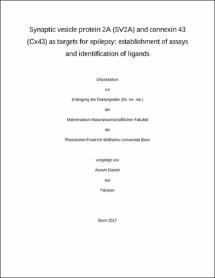Synaptic vesicle protein 2A (SV2A) and connexin 43 (Cx43) as targets for epilepsy: establishment of assays and identification of ligands

Synaptic vesicle protein 2A (SV2A) and connexin 43 (Cx43) as targets for epilepsy: establishment of assays and identification of ligands

| dc.contributor.advisor | Müller, Christa E. | |
| dc.contributor.author | Danish, Azeem | |
| dc.date.accessioned | 2020-04-24T09:36:13Z | |
| dc.date.available | 2020-04-24T09:36:13Z | |
| dc.date.issued | 12.09.2017 | |
| dc.identifier.uri | https://hdl.handle.net/20.500.11811/7270 | |
| dc.description.abstract | Epilepsy is a chronic neurological disorder affecting around 1% of the human population worldwide. The antiepileptic drugs (AEDs) available on the market provide symptomatic relief from epilepsy but do not cure the disease. Moreover, around 30% of epileptic patients remain resistant to treatment with the available AEDs. There is an unmet need for new AEDs exhibiting novel mechanism(s) of action resulting in disease-modifying properties. The AEDs levetiracetam (LEV, Keppra®) and its more potent derivative brivaracetam (BRV, Briviact®) exert their anticonvulsive effects through a unique mechanism of action, which is, however, still not well understood. The synaptic vesicle protein 2A (SV2A) was previously identified as the main target of LEV and BRV. However, LEV was also shown to modulate connexin 43 (Cx43) gap junction (GJ) channels in astrocytes, which may also contribute to its antiepileptic efficacy. In the present study, a radioligand competition assay suitable for compound library screening was established using [3H]BRV and cellular homogenates of Chinese hamster ovary (CHO) cells stably expressing human SV2A. A library of 500 approved drugs was tested for interaction with SV2A resulting in the identification of three new SV2A-interacting compounds, loratadine, quinine, and rimonabant. This discovery prompted us to screen an in-house library of 80 cannabinoids, which resulted in the identification of cannabidiol (CBD) as a potent ligand of SV2A with a Ki value below 1 µM. Thus CBD (Ki 0.719 µM) is similarly potent as LEV (Ki 1.74 µM) at SV2A. Our results support the idea that the already established anticonvulsive properties of quinine might be – at least partly – attributed to its interaction with SV2A. In fact, CBD has shown antiepileptic effects and was recently approved for the treatment of epilepsy syndromes (Dravet syndrome and Lennox-Gastaut syndrome). SV2A interaction may contribute to its antiepileptic activity which has so far been unknown. Binding studies with [3H]BRV at SV2A variants to investigate a potential role of the long intracellular cytoplasmic loop 3 (ICL3) of SV2A for LEV/BRV binding point towards the importance of the ICL3 for racetam binding. Previously proposed interaction partners of SV2A, namely galactose and botulinum neurotoxin A (BoNT/A) did not modulate [3H]BRV binding. Binding studies with [3H]BRV on recombinant Cx43 did not indicate the presence of a high-affinity binding site. Moreover, we developed a new screening assay for Cx43 GJ modulators which should be suitable for high-throughput screening. Lastly, the development of a novel method using capillary gel electrophoresis with a laser-induced fluorescence detector (CGE-LIF) for the quantification of green fluorescent protein (GFP)-tagged membrane proteins in a complex matrix such as cellular homogenates was reported. In conclusion, herein identified compounds interacting with SV2A may provide a basis for the development of new classes of antiepileptic drugs. The newly developed Cx43 GJ screening assay will help to screen large compound libraries to identify selective and potent modulators of Cx43 GJ channels. Furthermore, the new CGE-LIF based method provides a fast, robust, and reproducible approach to quantify various classes of membrane proteins containing a fluorescent tag. | en |
| dc.language.iso | eng | |
| dc.rights | In Copyright | |
| dc.rights.uri | http://rightsstatements.org/vocab/InC/1.0/ | |
| dc.subject | Brivaracetam | |
| dc.subject | Cannabidiol | |
| dc.subject | CGE-LIF | |
| dc.subject | Cx43 | |
| dc.subject | Epilepsie | |
| dc.subject | Gap Junctions | |
| dc.subject | HTS Assay | |
| dc.subject | Levetiracetam | |
| dc.subject | Radioligand-Bindungsstudien | |
| dc.subject | SV2A | |
| dc.subject.ddc | 615 Pharmakologie, Therapeutik | |
| dc.title | Synaptic vesicle protein 2A (SV2A) and connexin 43 (Cx43) as targets for epilepsy: establishment of assays and identification of ligands | |
| dc.type | Dissertation oder Habilitation | |
| dc.publisher.name | Universitäts- und Landesbibliothek Bonn | |
| dc.publisher.location | Bonn | |
| dc.rights.accessRights | openAccess | |
| dc.identifier.urn | https://nbn-resolving.org/urn:nbn:de:hbz:5n-48495 | |
| ulbbn.pubtype | Erstveröffentlichung | |
| ulbbnediss.affiliation.name | Rheinische Friedrich-Wilhelms-Universität Bonn | |
| ulbbnediss.affiliation.location | Bonn | |
| ulbbnediss.thesis.level | Dissertation | |
| ulbbnediss.dissID | 4849 | |
| ulbbnediss.date.accepted | 18.07.2017 | |
| ulbbnediss.institute | Mathematisch-Naturwissenschaftliche Fakultät : Fachgruppe Pharmazie / Pharmazeutisches Institut | |
| ulbbnediss.fakultaet | Mathematisch-Naturwissenschaftliche Fakultät | |
| dc.contributor.coReferee | Schiedel, Anke C. |
Files in this item
This item appears in the following Collection(s)
-
E-Dissertationen (4442)




